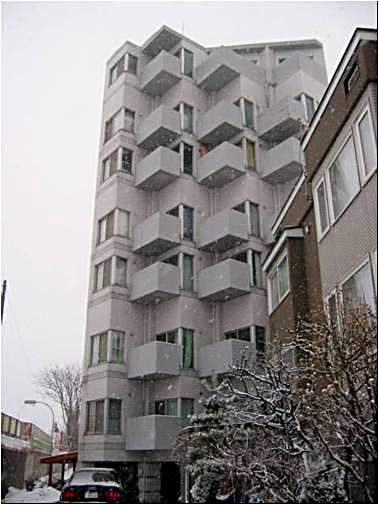
Having about 5,500 individual tenants gives us stable occupancy and rental rates, said executive director Raymond Wong. Photo by Leong Chan Teik.
SAIZEN REIT will resume distributing cash to unit-holders this Sep (halted in Jan 2009), now that it has refinanced all but one of its commercial mortgage-backed securities (CMBS) loans.
”We think people should look us in new light now that we have turned the corner,” said Saizen’s executive director Raymond Wong at an analyst briefing on Wed.
The REIT, which is the only one on the Singapore Exchange which invests in Japanese residential properties, ended the first 3 months of 2010 (3Q2010) with gross revenues of JPY 1 billion (S$15.8 million), largely unchanged from the preceding quarter in 2Q2010.
Net income attributable to unit-holders in 3Q2010 was JPY 95.3 million (S$1.5 million), compared with a loss of JPY 4.8 billion in 3Q2009. The loss in the previous financial period had been due to a recognition of a decline in the market value of its residential property portfolio during the financial crisis.
While the payout this September will be a token sum from income accumulated during May and Jun for FY2010, unit-holders can expect to benefit more from Saizen’s stable rental income for FY2011 onwards.
Its rental income is generated from 161 freehold properties comprising of 5,896 mass-market residential apartments, with occupancy above 90% even during the economic crisis. It also has 113 commercial units and 1,875 car parks.
More importantly, it has successfully refinanced all but one of its CMBS debt through bi-lateral bank loans, the suspension of distributions, a rights issue and operational cash flow.
| |||||||||||||||||||||||||||||||
Trading at 16.5 cents per share or a discount of 58% to book value, it is one of the cheapest SGX-listed REITs, with the sector average at a 17% discount to book.
During its IPO in 2007, its entire portfolio had been wholly financed by CMBS, but the extraordinary shutdown in the CMBS market in late 2007 left it high and dry as its loans became due for refinancing.
To refinance its mortgage loans, it managed to raise net proceeds of about S$41.1 million through a rights issue of 11 new shares with free warrants for 10 existing shares held in May last year.
The way out of CMBS has been hard, but through persistence, it is now able to obtain bi-lateral bank loans at long term interest rates not exceeding 4% p.a., with the latest two in Sep last year and Mar this year amounting to a total of JPY 3 billion (S$45.2 million).
It also raised JPY 667 million (S$10.1 million) by divesting 5 buildings during Aug to Oct 2009. The good news is: Despite the buildings being from the distressed portfolio, it managed to let go of them at close to valuation (ranging from 7% premium to 9% discount), instead of at fire sale prices as in foreclosures.

One lesson we learnt was the importance of taking loans that are non recourse, said CEO Chang Sean Pey. Photo by Leong Chan Teik
If it doesn’t redeem the loan in default, it will have to pay interest at 7.07%, which translates to a ballpark figure of some half a billion yen a year (S$7.5 million).
In event that the loan servicer forecloses on the YK Shintoku collateral, a scenario described by the management as being unlikely based on current indications by the loan servicer, the financial impact can be summarized follows:
Firstly, 10% will be knocked off Saizen’s net asset value, far less than the 58% that the stock market is knocking off its book value.
Secondly, its gearing will improve from 36.9% currently to 27.4%.
Finally, the management estimates that JPY 600 million (S$10.4 million) will be knocked off its net property income each year, but it will also be released from S$7.5 million of interest obligation.
Doesn’t it then make sense for Saizen to just walk away from YK Shintoku?
”We value the goodwill and reputation that will result from redeeming the loan in default,” said its CEO Chang Sean Pey.
With newfound confidence from its recent fund raising successes, Saizen is hoping to secure financing at no more than 4% to redeem the real estate portfolio managed under YK Shintoku.
"One third of our real estate portfolio is currently unencumbered by debt, and we can gear up on this," said Mr Chang.
”Asset risk for redeeming YK Shintoku is lower than buying a new property because it has proven occupancy rates and we have experience managing it,” he concluded.
Related story: SAIZEN REIT: Net asset value 40 cts, stock price 16 cts







